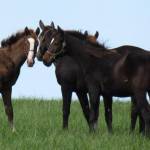Role of Nutrition Management in Farm-Wide Incidence of Skeletal Problems

Many horse farms have had an occasional foal that is born with, or eventually shows, problems with proper skeletal development. However, if a farm sees these problems in more than just a few foals each year, there may be some particular genetic predisposition, horse care practice, environmental factor, or nutritional element, either for mares or their foals, that is out of line.
The first step in identification of a herd problem is to determine if the individual occurrences of disturbed bone formation have anything in common. The clinical signs may be different, but the problem may be the same because the same disturbance will affect different sites at different ages under different circumstances. The investigation of a herd problem begins by examination of the individual problems. Identification of any common factors among individual cases, and retrospective identification of where in the growth process the bone formation problems are occurring, is most likely to result in help with a farm-wide problem. Concurrent ration analysis should also occur and be reviewed by a competent nutritionist. Marginal deficiencies can often lend clues as to where the bone formation disturbance is occurring. Integration of ration analysis information, bone formation disturbance data, and management schedules are the best clues to the cause of a herd problem, if one exists.
Some horses have more than one manifestation of developmental orthopedic disease simultaneously, and often many horses are affected on the same farm. On some farms, the problem recurs annually. Though developmental orthopedic disease is multifactorial, clinical impression suggests that one variable needing investigation in most large scale multi-horse manifestations of the disease is the diet. The diet is also the only easily manipulated factor. Though dietary changes are often helpful, they cannot prevent the disease completely because it is caused by many factors. Genetics and management are two additional major factors. Since genetics is an important contributor, elimination of all genetically predisposed animals would solve much of the problem. However, even if all carrier animals were identified, it is doubtful if a purge would occur since many of the producers of offspring with bone formation problems are also producers of talented athletes. These animals are often kept in the breeding program in spite of their possible genetic flaws.
Results of a study at Ohio State University indicate that there is a strong relationship between ration and farm problems. It appeared likely in that study that calcium, phosphorus, copper, and zinc deficiencies were involved in the development of epiphysitis, contracted tendons, and OCD lesions in yearlings. Since protein and energy levels were similar on all farms in the study, it is unlikely that they are directly involved in this disease process. In fact, farms with the most problems had the lowest protein levels in the study. From the data collected in the survey, it is apparent that the quality of nutrition, as well as the quantity, plays a significant role in the development of metabolic bone disease. In addition to correct nutrition, proper management practices are part of the development of a normal foal. Any variation from the original ecological niche of the horse presents a potential for disruption. Extreme variations from normal management practices should be looked at most closely.








